Chrysler New Yorker
| Chrysler New Yorker | |
|---|---|
 1970 Chrysler New Yorker 2-Door Hardtop | |
| Overview | |
| Manufacturer | Chrysler (division) |
| Model years | 1940–1996 |
| Layout |
FR layout (1940–1982) FF layout (1983–1996) |
| Chronology | |
| Successor | Chrysler LHS |
The Chrysler New Yorker is an automobile model which was produced by Chrysler from 1940 to 1996, serving for several years as the brand's flagship model. A trim level named the "New York Special" first appeared in 1938 and the "New Yorker" name debuted in 1939. Until its discontinuation in 1996, the New Yorker had made its mark as the longest running American car nameplate.
The New Yorker name helped define the Chrysler brand as a maker of upscale models priced and equipped above mainstream brands like Ford, Chevrolet/Pontiac, and Dodge/Plymouth, but below full luxury brands like Cadillac, Lincoln and Packard. During the New Yorker's tenure, it competed against upper level models from Buick, Oldsmobile and Mercury.
1940–1942
| First generation | |
|---|---|
 1940 New Yorker Highlander Convertible Coupe | |
| Overview | |
| Model years |
1940–1942 (from 1938 as a version of the Imperial) |
| Body and chassis | |
| Body style |
2/4-door sedan 2-door coupe 2-door convertible |
| Layout | FR layout |
| Related |
Chrysler Saratoga Chrysler Imperial |
| Powertrain | |
| Engine |
298.7 cu in (4.9 L) C-19 I8 323.5 cu in (5.3 L) C-23, 26, 30, 36 I8 |
| Transmission | 3-speed manual |
| Dimensions | |
| Wheelbase |
125 in (3,175 mm) (1938-1939) 128.5 in (3,264 mm) (1940) 127.5 in (3,238 mm) (1941-1942) |
The New York Special model was originally introduced as a distinct sub-series of the 1938 Chrysler Imperial. It was available in 1938 as a four-door sedan with a 298.7 CID straight-eight engine and a generous amount of comfort and space to the passengers (series C19).[1] For 1939 it was expanded with two more coupe versions and a two-door sedan and a larger, more powerful engine. Now the C23 series, it took on the "New Yorker" name, dropping the "Special" tag.[2]
1940
The first convertibles were introduced with the all-new body-design of the 1940 models. This, the C26 series, was the first New Yorker to be considered a standalone model rather than as an Imperial version.[3] It also saw the introduction of Fluid Drive, a fluid coupling between the engine and the clutch. The only transmission available was the basic three-speed manual. There was also the "New Yorker Highlander", a special version with tartan seats and other interior elements.[4]
1941
.jpg)
Lightly redesigned bodies were introduced for 1941, with the business coupe now being of the three window design. The bodies were all marginally wider and lower, with increased glass surface. Another new model was the Town Sedan with the rear doors having the hinges at the forward edge of the doors. This year, the Vacamatic was made available, although unlike the version sold on six-cylinder models, the Saratoga/New Yorker version was a three speed transmission with overdrive.
1942
With America entering World War II on 7 December 1941, all automobile production came to an end at the beginning of February, 1942. Thus, the 1942 model year was roughly half the normal length. Cars built after December 1941 had blackout trim.[3] The 1942s were quite modern, of a design which was heralding the post-war ponton style with fenders more incorporated into the bodywork. The grille consisted of five horizontal chrome bars which wrapped around the front, reaching all the way to the leading edge of the front wheelhouses. 12,145 New Yorkers of the C36 series were built this year.[3]
Chrysler would produce and experiment with engines for tanks and aircraft during World War II. One post-war application of this would lead to the creation of the first generation Hemi of the 1950s.
1946–1948
| Second generation | |
|---|---|
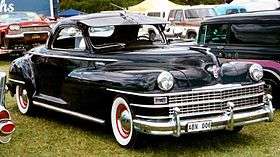 1947 Chrysler New Yorker Coupe | |
| Overview | |
| Model years | 1946–1948 |
| Body and chassis | |
| Body style |
4-door sedan 2-door coupe 2-door convertible |
| Layout | FR layout |
| Related |
Chrysler Saratoga Chrysler Newport Chrysler Windsor Chrysler Royal DeSoto Custom DeSoto Deluxe |
| Powertrain | |
| Engine | 323 cu in (5.3 L) I8 |
| Transmission | 3-speed manual |
| Dimensions | |
| Wheelbase | 127.5 in (3,238 mm) |
.jpg)
After the war, the New Yorker became a separate series.
Unlike most car companies, Chrysler did not make major changes with each model year from 1946 through 1948. Thus models for 1946 through 1948 Chryslers have the same basic appearance, noted for their 'harmonica' grille, based on the body introduced with the 1941 models. 1947 saw a minor redesign in tires, trim, and instrument panel, while the first 1948s were just 1947s with no visible changes.
Postwar Chryslers continued to offer Fluid Drive, with the New Yorker now offering the true four speed semi-automatic transmission.
1949–1954
| Third generation | |
|---|---|
.jpg) 1949 Chrysler New Yorker Town & Country Convertible Coupe | |
| Overview | |
| Model years | 1949–1954 |
| Body and chassis | |
| Body style |
4-door sedan 2-door coupe 2-door hardtop 2-door convertible 4-door station wagon |
| Layout | FR layout |
| Related |
Chrysler Imperial Chrysler Town and Country Chrysler Saratoga Chrysler Windsor Chrysler Royal DeSoto Custom DeSoto Deluxe DeSoto Firedome DeSoto Powermaster |
| Powertrain | |
| Engine | |
| Transmission |
2-speed automatic 4-speed semi-automatic |
| Dimensions | |
| Wheelbase | 131.5 in (3,340 mm) & 125.5 in (3,190 mm)[5] |
| Length | 211.75 in (5,378 mm) (1949–1950);[5] 213.25 in (5,417 mm) (1951–1952)[6][7] |
| Width | 75.12 in (1,908 mm) (1949–1952);[6] 76.25 in (1,937 mm) (1953)[8] |
| Height | 62.75 in (1,594 mm) (1953)[8] |
1949–1950
The 1949 New Yorker used Chrysler Corporation's new postwar body also shared by Dodge and DeSoto with ponton, three-box styling. The engine continued to be the 323.5-cid straight eight coupled to Fluid Drive and the Prestomatic four-speed semi-automatic. Body styles were reduced to club coupe, four-door sedan and convertible. Wheelbase on the New Yorker was increased to 131.5 in (3,340 mm) from the 127.5 in (3,240 mm) frame introduced in 1941. The previous design had been carried through early 1949, with the new (C46) series having been delayed due to a strike in late 1948.[9]
The 1950 New Yorker was the more deluxe of the regular eight-cylinder Chryslers (Saratoga being the eight with plainer trim) with cloth upholstery available in (unusual for 1950) several colors, 135 hp (101 kW) Spitfire straight-eight engine and roomy interior featuring "chair height" seats. The "Prestomatic" fluid drive transmission had two forward ranges, each with two speeds. In normal driving, high range was engaged using the clutch. The car could then be driven without using the clutch (unless reverse or low range was required); at any speed above 13 mph (21 km/h), the driver released the accelerator and the transmission shifted into the higher gear of the range with a slight "clunk". When the car came to a stop, the lower gear was again engaged.
The big news for 1950 was the two-door hardtop, or Special Club Coupe as Chrysler called it, in the New Yorker series. The model was called the Newport in sales literature. Also, Chrysler added foam rubber padding on the dashboard for safety.[10]
1951

Chrysler introduces the 180 hp (130 kW) FirePower Hemi engine. The engine becomes a popular choice among hot rodders and racers alike, a trend that continues to thrive today with its namesake second generation model. The FirePower Hemi equipped cars could accelerate 0 to 60 mph (97 km/h) in 10 seconds, faster than the Oldsmobile 88 Rocket engine of that time.
The New Yorker also offered Fluid Torque Drive, a true torque converter, in place of Fluid Drive. Cars with Fluid Torque Drive came only with Fluid Matic semi-automatic transmission and had a gear selector quadrant on the steering column. Power steering, an industry first, appeared as an option[11] on Chrysler cars with the Hemi engine. It was sold under the name Hydraguide.
A station wagon was offered for 1951, with only 251 built. Its 131.5 in (3,340 mm) wheelbase is the longest wheelbase ever used on a station wagon.
1952
Small redesign on taillights with the backup lights in the lower section. Last year for the 131.5 in (3,340 mm) wheelbase chassis for the New Yorker.
In 1952 Harold A. Clark used a New Yorker as the base for a full-size sports car called the Clark Cyclonic. The price was approximately $15,000 dollars and Clark planned to produce 48 during the first year. Whether this car ever reached production is not known.[12] Francisco Rocha was the first to purchase one.
1953
A less bulky look with the wheelbase reduced to 125.5 in (3,190 mm),[8] a one-piece curved windshield[13] and rear fenders integrated into the body. Wire wheels were now an option. The Saratoga of 1952 became the New Yorker for 1953 while the former New Yorker was now the New Yorker DeLuxe. The convertible and Newport hardtop were available only in the New Yorker DeLuxe while the base New Yorker offered a long wheelbase sedan and a Town & Country wagon. The convertible was New Yorker's costliest model on the 125.5 in (3,190 mm) chassis for 1953 at $3,980 – only 950 were built. Also new were pull-style exterior door handles.[14]
1954
The 1954 was a premium version of a standard 1950s size body. Chrysler's interest in six cylinder vehicles began to wane in favor of the popular FirePower Hemi V8. The New Yorker was priced a little more affordably, at $3,230 for the standard and $3,400 for the DeLuxe.
The standard model had a mild 195 hp (145 kW) output while the DeLuxe was used as a testbed of the engine's capabilities by outputting 235 hp (175 kW). (Such power was unheard of in 1954 from its competitors.)
Although introduced very late in the 1953 model year, all 1954 New Yorkers were available with the new two speed Powerflite automatic transmission. Fluid Torque Drive and Fluid Matic were dropped. 1954 was the last year the long wheelbase sedan was offered by Chrysler.
1955–1956
| Fourth generation | |
|---|---|
|
1956 Chrysler New Yorker Convertible Coupe | |
| Overview | |
| Model years | 1955–1956 |
| Body and chassis | |
| Body style |
2-door hardtop 2-door convertible 4-door sedan 4-door hardtop 4-door station wagon |
| Layout | FR layout |
| Related |
Chrysler 300 Chrysler Town and Country Chrysler Windsor DeSoto Fireflite DeSoto Firedome DeSoto Adventurer |
| Powertrain | |
| Engine | 392 cu in (6.4 L) V8 |
| Transmission | 3-speed automatic |
| Dimensions | |
| Wheelbase | 126.0 in (3,200 mm) |
| Length | 218.8 in (5,558 mm) (1955–1956)[15] |
| Width | 79 in (2,007 mm) [15] |
1955
.jpg)
In 1955, Chrysler did away with the out of fashion high roofline designs of K.T. Keller and came out with a new sedan that borrowed styling cues from Virgil Exner's custom 1952 Imperial Parade Phaeton. The hemi engine produces 250 hp (190 kW) this year. The result would become an ongoing trend for increasing engine output throughout the next two decades with Chrysler and its rival competitors. The Powerflite transmission was controlled by a lever on the instrument panel.
The series was called New Yorker DeLuxe with the base New Yorker dropped. The club coupe was dropped being replaced by the Newport two-door hardtop. A new higher priced St.Regis two-door hardtop filled the spot of the former Newport. The sedan, convertible and Town & Country wagon were still offered.
1956

In 1956, Chrysler christened this model year "PowerStyle" and it was one of the design works of Virgil Exner. The New Yorker gained a new mesh grille, leather seats, pushbutton PowerFlite selector, and a V8 with 280 hp (210 kW).
The St. Regis two-door hardtop gave a unique three-tone paint job for a higher price and the Town and Country Wagon model was Chrysler's most expensive vehicle of 1956 at US$4,523. This was the first year for the New Yorker 4-door pillarless hardtop. Only 921 convertibles were made.
1957–1959
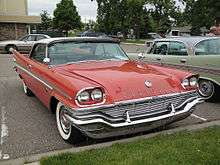
| Fifth generation | |
|---|---|
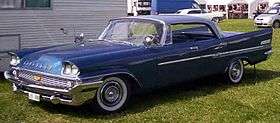 1958 Chrysler New Yorker 4-Door Hardtop | |
| Overview | |
| Model years | 1957–1959 |
| Body and chassis | |
| Body style |
2-door hardtop 2-door convertible 4-door sedan 4-door hardtop 4-door station wagon |
| Layout | FR layout |
| Related |
Chrysler 300 Chrysler Town and Country Chrysler Saratoga Chrysler Windsor DeSoto Adventurer DeSoto Fireflite DeSoto Firedome |
| Powertrain | |
| Engine | 392 cu in (6.4 L) V8 |
| Transmission | 3-speed automatic |
| Dimensions | |
| Wheelbase | 126.0 in (3,200 mm) |
| Length |
219.2"(1957)[16] 220.9(1959)[17] |
1957
This year, Chrysler cars were redesigned with Virgil Exner's "Forward Look" at the cost of $300 million. The 1957 New Yorker had a powerful 392 cu in (6.4 L) Hemi V8 engine rated at 325 hp (242 kW). This stylish car sold well with 10,948 built, but only 1,049 convertible models. The 1957 models also came with the TorqueFlite 3-speed automatic transmission and a Torsion bar suspension called Torsion-Aire that gave smoother handling and ride quality to the car. The New Yorker also sported fins that swept up from just behind the front doors.
Early model year production had single headlamps with quad headlamps optional where state regulations permitted them. The single headlamps were dropped later in the year.[18]
1958
Forward Look remains intact but with new body-side trim, shrunken taillights and 345 hp (257 kW). The convertible model was still available, with only 666 made and only 15 working convertibles are known to still exist in 2008.[19] Sales were steady, but decreased from last year due to The Recession of 1958. The car's reputation was also tainted due to rust problems caused by rushed production and testing.
The biggest news from Chrysler in 1958 was the introduction of a cruise control system called "Auto-Pilot"[20]

1959
The New Yorkers this year had a new 413 cu in (6.8 L) 350 hp (260 kW) Golden Lion V8, new tailfins, new front end, and no Hemi. The FirePower (1G) Hemi ended production and was replaced by the less expensive and lighter wedge head engine. The Hemi would never return to the New Yorker and slowly ended its image as a performance car and re-branded it as a luxury car, ushered in with styling similar to the Imperial of 1958. The Hemi engine itself would not return to Mopar cars until 1964 with the second generation 426 Hemi.
1960–1964
| Sixth generation | |
|---|---|
 1960 Chrysler New Yorker 2-Door Hardtop | |
| Overview | |
| Model years | 1960–1964 |
| Body and chassis | |
| Body style |
2-door hardtop 2-door convertible 4-door sedan 4-door hardtop 4-door hardtop station wagon |
| Layout | FR layout |
| Related |
Chrysler 300 Chrysler Town and Country Chrysler Saratoga Chrysler Windsor Chrysler Newport Dodge Custom 880 |
| Powertrain | |
| Engine | 413 cu in (6.8 L) V8 |
| Dimensions | |
| Wheelbase |
126.0 in (3,200 mm) 1963–64: 122.0 in (3,099 mm) |

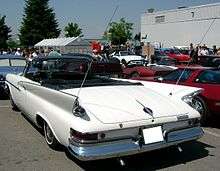
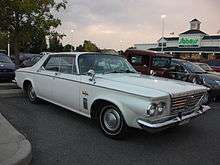

1960
This year had unibody construction, the carry-over RB engine had an output of 350 hp (260 kW).
1961
The New Yorker entered 1961 with a new grille, slanted headlights, a continental kit on the trunk lid. The 413 CID "RB" Golden Lion V-8 continued. This is the last of the "Forward Look" models. Chrysler built 2,541 New Yorker two-door hardtops this year, the last until 1964 in Canada and 1965 in the U.S.
1962
The classic Chrysler fins that made the car unique no longer existed and now only 4-door models were offered in wagon, sedan, and hardtop models. The finless car was considered "bizarre" by many critics and sales were slow compared to its entry level sister car, the Newport which was identical in body style and offered a convertible model. The New Yorker was the last Chrysler to have a 126 in (3,200 mm) wheelbase.[21]
The 413 RB had a 4.1875 in (106 mm) bore and was used from 1959-1965 in cars. During that period, it powered all Chrysler New Yorker and Imperial models, and was also available on the lesser Chryslers, as well Dodge's Polara and Monaco, and the Plymouth Fury as an alternative to the 383-cubic-inch B series engine and/or the 318 Poly. With a compression ratio of 10:1, it developed 340 brake horsepower and 470 lb-ft of torque in 1X4-Bbl trim.
1963
Chrysler got a boost in sales in 1963 with the introduction of a 5-year/50,000-mile warranty, a business practice that was unheard of by its competitors in the 1960s. The New Yorker used Chrysler's completely redesigned body with only the windshield showing traces of the previous Forward Look designs, although, under the skin, platform changes were near zero, with only a change from 12" Total Contact to Bendix 11" Duo-Servo brakes. A new, more luxurious Salon four-door hardtop was added at midyear as a trim package. Engine output is 340 hp (250 kW) and the wheelbase is now 122 in (3,100 mm).
1964
Changes for 1964 included a new grille, larger rear window and small tailfins giving the car a boxier look from the side. Canadians were given the choice of a new two-door hardtop, while Americans got the Salon option on the four-door hardtop and post.
1965–1968
| Seventh generation | |
|---|---|
|
1965 Chrysler New Yorker 4-Door Sedan | |
| Overview | |
| Model years | 1965–1968 |
| Body and chassis | |
| Body style |
2-door hardtop 4-door sedan 4-door hardtop |
| Layout | FR layout |
| Platform | C-body |
| Related |
Imperial Chrysler 300 Chrysler Town and Country Chrysler Newport Dodge Monaco Dodge Polara Plymouth Fury |
| Powertrain | |
| Engine |
440 cu in (7.2 L) RB V8 413 cu in (6.8 L) V8 |
| Dimensions | |
| Wheelbase | 124.0 in (3,150 mm) |

1965
All Chryslers (as well as large Plymouth and Dodges) were now built on an all-new C-body unibody platform which featured a bolt-on, rubber-isolated front sub frame. Elwood Engel designed the '65 New Yorker (and all Chrysler models) with styling cues from his 1961 Lincoln Continental — square side view with chrome trim along the top edges of the fenders. The options were: a 413 CID V8, dual pipe exhaust and power options (A/C, windows, antenna and steering). The engine itself put out 375 hp (280 kW) and was phased out for the 440 Firepower next model year. The styling began to share some visual similarities with the premium luxury sedan Imperial which received an all-new appearance in 1964.
Factory options for 1965 included a 350 hp 413 ci Firepower engine, vinyl rear roof pillar insert, Saginaw-sourced Tilt 'N Telescopic steering wheel and standard power options.
For 1965, the 4-door sedan used the six-window Town Sedan style which also used by the 1965 Chrysler Newport and Dodge Custom 880. The two-door hardtop was now sold in the U.S. Wheelbase of New Yorker models, except the wagon, was 124 in (3,100 mm). The Town & Country wagon was on the Dodge's 121 in (3,100 mm) wheelbase as all C body wagons shared the same basic body.
1966
For 1966, the Chrysler New Yorker adopted the new 440-cid V8 engine. Styling changes included a new grille, taillamps and revised side trim. The Town & Country wagon was dropped as the model was now marketed as a series on its own.
Overall, 1966 was a good sales year for Chrysler with a steady increase in production and sales.
1967
1967 brought sheetmetal redesign below the belt line with wraparound parking lights at the front and taillights at the rear. A new fasttop design for the two-door hardtop replaced the more formal look of 1965–1966. The four-door sedan reverted to the four-window style as used on the Newport sedan and it had the new 440-cid engine
Sales slumped 20%, the company's lowest in five years due to an economic slump this year.
1968
Changes included new front and rear treatments. Although the Newport and 300 four-door hardtops received a new, sportier roofline shared with Dodge and Plymouth, the New Yorker continued with the roofline first introduced for 1965.
Sales rebounded with the year setting a record at 263,266 cars built.
1969–1973
| Eighth generation | |
|---|---|
.jpg) 1971 Chrysler New Yorker 4-Door Hardtop | |
| Overview | |
| Model years | 1969–1973 |
| Body and chassis | |
| Body style |
2-door hardtop 4-door sedan 4-door hardtop |
| Layout | FR layout |
| Platform | C-body |
| Related |
Imperial Chrysler 300 Chrysler Town and Country Chrysler Newport Dodge Monaco Dodge Polara Plymouth Fury |
| Powertrain | |
| Engine | 440 cu in (7.2 L) RB V8 |
| Transmission | 3-speed A-727 automatic |


1969
Chrysler big C bodies received a major reworking with curved sides and a higher belt line. Underneath the new look were the underpinnings of 1965. The new look was called "Fuselage Styling" and was shared with the restyled Imperial. The two-door hardtop received a new look harking back to the club coupes of the 1940s.
1970
The 1970 Chryslers received minor styling changes to the grille, taillamps and trim. The small vent windows on the front doors were dropped on the two-door hardtops.
1971
Due to sales that were less than expected, the facelift scheduled for 1971 was put off until 1972. Thus the 1971 models received new grilles and revised taillamps, changes that took a sharp eye to note. Ventless front-door windows on the four-door sedan and hardtop were new this year.
1972
For 1972, Engine power dropped to meet stricter emissions standards and rising gas prices. Chryslers received a new 'split grille' somewhat similar to the Dodge Chargers of 1971-1974. This would be the last year for the 'loop'-style front bumpers on Chryslers.
1973
The final year for the distinctive Chrysler "Fuselage Styling".
1974–1978

| Ninth generation | |
|---|---|
 1976 Chrysler New Yorker Brougham 4-Door Hardtop | |
| Overview | |
| Model years | 1974–1978 |
| Body and chassis | |
| Body style |
2-door coupe 2-door hardtop 4-door sedan 4-door hardtop |
| Layout | FR layout |
| Platform | C-body |
| Related |
Imperial Chrysler Town and Country Chrysler Newport Dodge Monaco Plymouth Fury Plymouth Gran Fury |
| Powertrain | |
| Engine |
440 cu in (7.2 L) V8 400 cu in (6.6 L) V8 360 cu in (5.9 L) V8 |
| Dimensions | |
| Wheelbase | 124"[22] |
| Length | 232.7 in (5,911 mm) |
1974
The so-called "fuselage" styling featured on all full size Chrysler products remained relatively unchanged until the introduction of the 1974 models which featured a far more massive slab sided effect. This generation introduced covered headlights, and a more prominent "waterfall" style grille, reflecting popular styling appearances, primarily used on the Lincoln Continental.
These 1974 models timed to coincide precisely with the 1973 OPEC oil embargo, and were a significant part of Chrysler's economic woes in the late 1970s. The 1974 models were the last full-size models Chrysler designed from the ground up.[23] Two New Yorker trim levels were offered in 1974, the base New Yorker and an upgraded New Yorker Brougham. A new St. Regis option package was added mid-year.
1975
For 1975, the New Yorker received a slightly revised grille and New Yorker Brougham became the sole trim designation. The St. Regis package, introduced in mid-1974, returned for its first full year.
1976
In 1976, the New Yorker inherited the front and rear end styling of the discontinued Imperial, and its interiors as well. The Imperial styling gave the New Yorker an unforeseen boost in sales, as the car looked distinctly different from the lower priced Newport. The styling cues formerly used on the 1974 and 1975 New Yorkers in turn were passed on to the base Chrysler Newport.
1977
The standard 440-cid V8 engine was now computer-controlled with a new "lean burn" system allowing for more responsive acceleration and performance.
1978
The 400-cid (360-cid in California and high altitude regions) V8 was now the standard engine with the 440-cid V8 becoming optional. 1978 was the last year a 2-door New Yorker was offered. Oddly, the last year of the C-body New Yorker Broughams saw engineering changes that include a revised windshield wiper linkage bushing, redesigned front and rear plastic fender extensions for the bumpers, and thinner glass.
1979–1981
| Tenth generation | |
|---|---|
.jpg) 1980 Chrysler New Yorker | |
| Overview | |
| Model years | 1979–1981 |
| Assembly | Detroit, Michigan, United States (Lynch Road Plant) |
| Body and chassis | |
| Body style | 4-door sedan |
| Layout | FR layout |
| Platform | R-body |
| Related |
Chrysler Newport Dodge St. Regis Plymouth Gran Fury |
| Powertrain | |
| Engine |
318 cu in (5.2 L) V8 360 cu in (5.9 L) V8 |
| Dimensions | |
| Wheelbase | 118.5 in (3,010 mm) |
| Length | 221.5 in (5,626 mm) |
| Width | 77.1 in (1,958 mm) |
| Height | 54.5 in (1,384 mm) |
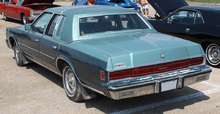
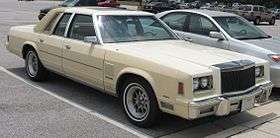
1979
The R-body series was a "Pillared Hardtop." It now used the 318 V8; the 360 engine was optional through 1980. While shorter and much lighter than the previous generation, these cars still had a big car look and ride. Hidden headlamps and full-width taillights distinguished it from its R-body siblings Newport, St. Regis and Gran Fury. A new "Fifth Avenue" trim package was offered.
1980
In addition to last year's "Fifth Avenue" package, a limited production "Fifth Avenue Limited Edition" package was also offered featuring brushed stainless steel roof treatment and exclusive mahogany metallic paint.
1981
A bold new grille, with simple vertical ribs, appeared for 1981. The “Fifth Avenue” option package was again available plus a new "Carriage Roof" package was added. This package was available fully loaded with few options and was available only in nightwatch blue or mahogany metallic.
| Year | Units |
|---|---|
| 1979 | 54,640 |
| 1980 | 13,513 |
| 1981 | 6,548 |
| Total Production = 74,701 | |
1982
| Eleventh generation | |
|---|---|
 | |
| Overview | |
| Model years | 1982 |
| Assembly | Windsor, Ontario, Canada |
| Body and chassis | |
| Body style | 4-door sedan |
| Layout | FR layout |
| Platform | M-body |
| Related |
Chrysler Fifth Avenue Chrysler LeBaron Dodge Diplomat Plymouth Gran Fury/Caravelle |
| Powertrain | |
| Engine |
225 cu in (3.7 L) RG I6 318 cu in (5.2 L) LA V8 |
| Dimensions | |
| Wheelbase | 112.7 in (2,863 mm) |
| Length | 206.7 in (5,250 mm) |
| Width | 74.2 in (1,885 mm) |
| Height | 55.3 in (1,405 mm) |
In an effort of downsizing, the 1982 Chrysler New Yorker (and the Fifth Avenue trim) moved to the corporate M-body. In turn, the Chrysler LeBaron, which had previously used the M-body, moved to the compact K-body this year. The 1982 New Yorker was not a completely new vehicle. It was essentially a restyled and upgraded version of the LeBaron which had been produced since 1977. This M-body New Yorker used Chrysler's slant 6 engine. The 318 in³ engine was optional.
The 1982 New Yorker was available in two trims: Base and Fifth Avenue. Both used the formal roof treatment. The Fifth Avenue package gave buyers a choice of pillowed Corinthian leather or Kimberley velvet seats while base models had cloth or optional leather seats. This car became the Chrysler New Yorker Fifth Avenue for 1983 and for 1984 the "New Yorker" prefix was dropped altogether; becoming the Chrysler Fifth Avenue.
| Year | Units |
|---|---|
| 1982 | 50,509 |
1983–1988
| Twelfth generation | |
|---|---|
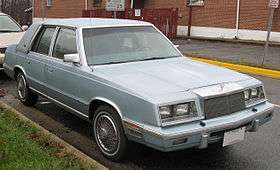 1987 Chrysler New Yorker | |
| Overview | |
| Also called | Chrysler New Yorker Turbo |
| Model years | 1983–1988 |
| Assembly |
Detroit, Michigan United States (Jefferson Avenue Assembly) Toluca Assembly Plant (Toluca, México) 1986-1989 |
| Body and chassis | |
| Body style | 4-door sedan |
| Layout | Transverse front-engine, front-wheel drive |
| Platform | E-body |
| Related |
Chrysler E-Class Dodge 600 Plymouth Caravelle |
| Powertrain | |
| Engine |
2.2 L K I4 2.2 L Turbo I I4 2.5 L K I4 2.6 L Mitsubishi G54B I4 |
| Transmission |
3-speed A413 automatic 3-speed A470 automatic |
| Dimensions | |
| Wheelbase | 103.3 in (2,624 mm) |
| Length | 187.2 in (4,755 mm) |
| Width | 68.0 in (1,727 mm) |
| Height | 53.1 in (1,349 mm) |
.jpg)
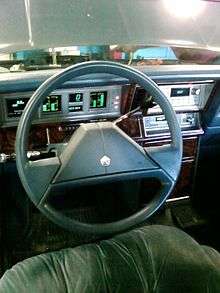
1983
In 1983, the New Yorker name was used on two different models. The M-body car was now the "New Yorker Fifth Avenue" a name which changed to simply "Fifth Avenue" from 1984 to 1989. The other was an all new K-car based New Yorker, which used the front-wheel drive Chrysler E platform, the beginning of the extended K-car years.
The E-platform New Yorker came with state-of-the-art 1980s technology, including a digital dashboard and Electronic Voice Alert, which spoke notifications such as "A door is ajar"; "Please fasten your seat belts"; "Don't forget your keys"; "Thank you" (when you fastened your seat belt, closed the door tightly or removed the key from the ignition switch); "Your engine oil pressure is low - prompt service is required". Also standard was a Landau vinyl roof with electroluminescent opera lamps. This was the only Chrysler New Yorker generation with an inline-four engine.
1983 was a limited production year for the FWD New Yorker. When introduced in 1983, it shared many elements with the Chrysler E-Class and had a waterfall grille that was slightly different from the 1984-1988 versions.
1984
Restyled wraparound taillights and a revised front grille were among the cosmetic changes for 1984. A 2.2 L I4 turbo engine was now an option. New electronic instrumentation featured digital speedometer and odometer. Pillowed velvet seats replaced deep-nap cloth seats as standard.
1985
Standard engine switched from 2.2 L I4 to Mitsubishi-sourced 2.6 L I4. New standard interior features included overhead storage console with reading lamps, rear seat headrests, and power windows.
1986
Chrysler-built 2.5 L I4 replaced 2.6 L I4 as standard engine. Also new was an automatic load leveling suspension. Cosmetically, rear deck lid panels, moldings and taillights were redesigned. Interior changes included a new forward console and revised electronic instrumentation. AM/FM stereo and deluxe intermittent wipers were now standard.
1987
Hood vents were eliminated on turbo models, as were fender louvers on all models. A new six-speaker Infinity sound system was optional. As with other Chryslers, steering wheel was redesigned. 1987 was the best-selling and last full model year for the E-platform New Yorker.
1988
Although a new thirteenth generation New Yorker was introduced for 1988, the twelfth generation continued for one more abbreviated model year as the 1988 New Yorker Turbo. As the model name suggested, the 2.2 L I4 turbo was now the standard and only available engine. In addition to the turbo engine, previously optional yet commonly ordered equipment like automatic temperature control air conditioning, tilt steering wheel, cruise control, rear window defogger, and power door locks became standard.
While previous model year New Yorkers equipped with the optional turbo engine were also commonly referred to as a "New Yorker Turbo" and wore "Turbo" badges, only the 1988 model had it as its official model name.
| Year | Units |
|---|---|
| 1983 | 33,832 |
| 1984 | 60,501 |
| 1985 | 60,700 |
| 1986 | 51,099 |
| 1987 | 68,279 |
| 1988 (Turbo) | 8,805 |
| Total Production = 283,216 | |
1988–1993
| Thirteenth generation | |
|---|---|
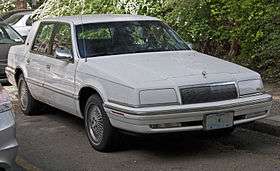 1992 Chrysler New Yorker Salon | |
| Overview | |
| Model years | 1988–1993 |
| Assembly | Belvidere, Illinois |
| Body and chassis | |
| Body style | 4-door sedan |
| Layout | Transverse front-engine, front-wheel drive |
| Platform | C-body |
| Related |
Chrysler New Yorker Fifth Avenue Chrysler Imperial Dodge Dynasty |
| Powertrain | |
| Engine |
3.0 L Mitsubishi 6G72 V6 3.3 L EGA V6 |
| Transmission |
3-speed A670 automatic 4-speed A604 automatic |
| Dimensions | |
| Wheelbase |
1988–1990: 104.3 in (2,649 mm) 1991–93: 104.5 in (2,654 mm) |
| Length | 193.6 in (4,917 mm) |
| Width |
1988–1990: 68.5 in (1,740 mm) 1991–93: 68.9 in (1,750 mm) |
| Height |
1988–1990: 53.5 in (1,359 mm) 1991–93: 53.6 in (1,361 mm) |

1988
The redesigned New Yorker for 1988 was bigger (see Chrysler C platform) and bore no resemblance to the E-body model it replaced although many underbody and suspension components were carryover. It shared similar upright body styling with the newly introduced Dodge Dynasty. This new version had a V6 engine — a Mitsubishi-sourced 3.0 liter powerplant, and optional anti-lock brakes. Base and Landau trim choices were offered, the latter of which carried a rear-quarter vinyl top. Hidden headlamps, a feature lost when the R-body cars were discontinued, made a return with this redesign.
All thirteenth generation New Yorkers, as well as the reintroduced flagship 1990-1993 Imperial, were covered by Chrysler's market-leading "Crystal Key Owner Care Program" which included a 5-year/50,000-mile limited warranty and 7-year/70,000-mile powertrain warranty. A 24-hour toll-free customer service hotline was also provided.
1989
For 1989, the 3.0 liter V6 engine had a slight horsepower increase and was now mated to a new 4-speed Ultradrive automatic transmission. This year also marked the 50th anniversary of the "New Yorker" name. Although no special anniversary edition or recognition was offered at the time, it turned out to be the most popular New Yorker of the model run with over 100,000 units produced that year.
1990
In 1990, a new base model New Yorker called "Salon" was added. The Salon was a rebadged Dodge Dynasty with exposed headlamps, horizontal taillights, and grille similar to the Dodge. The Salon was sold in Canada as the Chrysler Dynasty. All models carried a new Chrysler-built 3.3 L V6 engine that year. Minor changes to the interior included a more contemporary contoured dash. A driver's side air bag was now standard.
1991
The Landau model was dropped for 1991 but Salon was upgraded and now came with more standard equipment, hidden headlights, vertical taillights, and a traditional Chrysler grille.
1992
A styling update for 1992 produced a more rounded appearance front and rear. A padded landau roof, similar to one previously featured on the "Landau" model, was now an option on the Salon.
1993
Last year's restyle carried into 1993. The last thirteenth generation New Yorker rolled off the assembly line on May 28, 1993.
New Yorker Fifth Avenue
In 1990, a new stretched-wheelbase of the New Yorker was offered carrying the additional moniker of Fifth Avenue from the just-departed M-body platform. Although officially sold as the New Yorker Fifth Avenue, it was sometimes referred to as simply "Fifth Avenue." This model was discontinued in 1993.
| Year | Units |
|---|---|
| 1988 | 70,968 |
| 1989 | 100,461 |
| 1990 | 86,004 |
| 1991 | 55,229 |
| 1992 | 51,650 |
| 1993 | 52,128 |
| Total Production = 416,440 | |
1994–1997
| Fourteenth generation | |
|---|---|
 1995 Chrysler New Yorker | |
| Overview | |
| Also called | Chrysler LHS |
| Model years |
|
| Assembly | Brampton, Ontario, Canada |
| Body and chassis | |
| Body style | 4-door sedan |
| Layout | Longitudinal front-engine, front-wheel drive |
| Platform | Chrysler LH platform |
| Related |
Chrysler Concorde Chrysler LHS Dodge Intrepid Eagle Vision |
| Powertrain | |
| Engine | 3.5 L EGJ V6 |
| Transmission | 4-speed 42LE automatic |
| Dimensions | |
| Wheelbase | 113.0 in (2,870 mm) |
| Length | 207.4 in (5,268 mm) |
| Width | 74.4 in (1,890 mm) |
| Height |
1994: 55.7 in (1,415 mm) 1995–96: 55.9 in (1,420 mm) |
| Curb weight | 3,483–3,587 lb (1,580–1,627 kg) |

Early 1994
The last generation of the New Yorker continued with front-wheel drive on an elongated version of the new Chrysler LH platform and was shown at the 1992 North American International Auto Show in Detroit. It was released in May 1993 along with the nearly identical Chrysler LHS as an early 1994 model, eight months after the original LH cars: the Chrysler Concorde, Dodge Intrepid, and Eagle Vision, were introduced. The New Yorker came standard with the 3.5 L EGJ which produced 214 hp (160 kW). Chrysler gave the New Yorker a more "traditional American" luxury image, and the LHS a more European performance image (as was done with the Eagle Vision). Little separated New Yorker from LHS in appearance, with New Yorker's chrome hood trim, body-color cladding, standard chrome wheel covers and 15" wheels, column shifter and front bench seat, being the only noticeable differences. An option provided for 16" wheels and a firmer suspension type ("touring suspension"). This option eliminated the technical differences between New Yorker and LHS. LHS came with almost all of New Yorker's optional features as standard equipment and featured the firmer tuned suspension, to go with its more European image.
1994 Proper
At the start of the 1994 model year, some changes were carried through. On the outside, New Yorker now carried accent-color body cladding, whereas LHS received body-color cladding. This change aligned New Yorker with the Chrysler Concorde, that also had accent-color cladding. Instead of standard 15" and optional 16" wheels, for the sake of enhanced stability 16" wheels became standard and the 15" wheels were dropped. Likewise, the touring suspension option of the early 1994 model was canceled, leaving normal duty suspension ("ride-tuned") as the only suspension type. This resulted in a permanent technical difference with LHS.
1995
For 1995, the New Yorker received Chrysler's revived blue ribbon logo (which was last used in the 1950s) on its grille, which replaced the pentastar which had been used on models beginning in 1980.
1996
The 1996 model featured additional sound insulation and revised structural engineering to give it a quieter ride. A new built-in transmitter replaced the remote garage door opener. The antenna was now integrated in the rear window.
Due to similarities between the New Yorker and LHS, and the LHS's strong sales, the New Yorker name was dropped after a short 1996 production run. Despite being far more contemporary and monochromatic in design compared to previous models, the traditional New Yorker with its two-tone cladding and chrome trim still did not follow the modern, monochromatic styling trend of the division's other vehicles in 1996.
LH design background
The fourteenth, and final, generation New Yorker's design can be traced to 1986, when designer Kevin Verduyn completed the initial exterior design of a new aerodynamic concept sedan called Navajo. The design never passed the clay model stage.
It was also at this time that the Chrysler Corporation purchased bankrupt Italian sports car manufacturer Lamborghini. The Navajo's exterior design was reworked and became the Lamborghini Portofino, released as a concept at the 1987 Frankfurt Auto Show. The Portofino was heralded as a design triumph, setting in motion Chrysler's decision to produce a production sedan with the Portofino's revolutionary exterior design, called "cab-forward".
The cab forward design was characterized by the long, low slung windshield, and relatively short overhangs. The wheels were effectively pushed to the corners of the car, creating a much larger passenger cabin than the contemporaries of the time.
Design of the chassis began in the late 1980s, after Chrysler had bought another automaker: American Motors Corporation (AMC) in 1987. During this time, Chrysler began designing the replacement for the Dodge Dynasty and Chrysler Fifth Avenue as well as a potential Plymouth. The initial design of Dodge's LH bore resemblance to the Dynasty, and this design was scrapped entirely after François Castaing, formerly AMC's Vice President of product engineering and development, became Chrysler's Vice President of vehicle engineering in 1988. The new design, under Castaing's leadership, began with the Eagle Premier, also sold later as the Dodge Monaco.
The Premier's longitudinal engine mounting layout was inherited, as was the front suspension geometry, and parts of the braking system. The chassis itself became a flexible architecture capable of supporting front or rear-wheel drive (designated "LH" and "LX" respectively).
The chassis design was continually refined throughout the following years, as it underpinned more Chrysler prototypes: the 1989 Chrysler Millennium and 1990 Eagle Optima.
The transmission was inspired by the Eagle Premier's ZF automatic. However, it borrowed heavily from Chrysler's A604 (41TE) "Ultradrive" transversely mounted automatic, it became the A606 (also known as 42LE). This Ultradrive transmission however was not without critics as The New York Times reported on January 25, 1991 that Consumers Union would publish in the February 1991 issue of the magazine Consumer Reports a warning for consumers to not purchase a vehicle with this "Ultradrive" transmission citing poor reliability and safety hazards.
By 1990, it was decided that the new technologically advanced car would need a new technologically advanced engine to power it. Until that time, the only engine confirmed for use was Chrysler's 3.3 L pushrod V6, which would be used in the three original LH cars, the Intrepid, Vision, and Concorde, in base form. The 3.3 L engine's 60° block was bored out to 3.5 L, while the pushrod-actuated valves were replaced with SOHC cylinder heads with four valves per cylinder, creating an advanced 3.5 L V6 optional in the three smaller cars, but standard in LHS and New Yorker.
The general LH appearance, still based on the cab forward exterior design of the 1987 Lamborghini Portofino concept, with its aerodynamic shape, made for little wind noise inside this large car. This sleek styling gives the LH cars a low drag coefficient which was ahead of its time.
The New Yorker featured a more monochromatic design inside and out (but less so than its LHS sibling, which had very little chromed trim), and aluminum wheels with a Spiralcast design. The single color motif was more pronounced on models without the grey lower cladding.
Upscale New Yorker models feature leather-trimmed seats, steering wheel, shift knob and door inserts. Passenger comforts include rear center rear armrest, and 8-way power seats for both the driver and passenger, as well as personal reading lamps.
Power windows and central door locks were standard, as was climate control with air conditioning, and cruise control. remote keyless entry available as an option, as was a remote activated alarm, an overhead console with computer, power moonroof and alloy wheels. The best stock audio options found in New Yorker are the Infinity sound systems having eight speakers positioned throughout the cabin along with an equalizer. Head units include a radio with either cassette or CD playback, and up to a five-band adjustable graphic equalizer, with joystick balance and fade control
Standard safety features included dual front airbags, anti-lock brakes (ABS), and traction control.
Dual-way power sunroofs were available on this car. They were designed and installed by American Sunroof Corp. (now ASC Global) from its Columbus, Ohio plant, not by Mopar itself. An installed sunroof eliminated most of the front overhead console that featured storage bins for a garage door opener and sunglasses. However, the Overhead Travel Information System (OTIS), or onboard computer with integrated map lights, was retained.
LHS
The five-passenger Chrysler LHS was differentiated from its New Yorker counterpart by a floor console and shifter, five-passenger seating, lack of chrome trim, an upgraded interior and a sportier image. After a short 1996 production run the New Yorker was dropped in favor of a six-passenger option on the 1996-1997 LHS. The LHS received a minor face change in 1995 when the corporate wide pentastar emblem was replaced with the revived Chrysler brand emblem.
Being the top-of-the-line Chrysler, many features came standard on the LHS — features optional on its siblings. Some of these options included a body-colored grille, side mirrors and trim, traction control, aluminum wheels, integrated fog lights, and 8-way power adjustable front seats, premium sound systems with amplifiers, and automatic temperature control. Unlike the New Yorker, leather seats were standard.
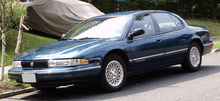
The headlamps on the 1994 models were very poorly designed and many owners complained about their poor brightness. Chrysler rushed the redesign into the production for 1995 model year. The new design used a projector-style headlight beam, something that was still somewhat uncommon for its time.
The 1995-1997 LHS was sold in Europe with the New Yorker nameplate and featured rear amber turn signals, rear fog lamps, side turn signal repeaters, and headlamps that incorporated different lens geometry and bulbs, The side markers were deleted. 1996-1997 LHS exports to South Korea and the Middle East likewise bore the New Yorker nameplate. South Korean exports looked like a European New Yorker, Middle East exports like an American LHS.
The first generation LHS was praised by motoring journalist Jeremy Clarkson, who is well known for criticizing American automobiles but described the LHS as "by global standards, right up there with the best."[25]
NEW YORKER PRODUCTION
| Year | Units |
|---|---|
| 1994 | 34,283 |
| 1995 | 23,624 |
| 1996 | 3,295 |
| Total Production = 61,202 | |
LHS PRODUCTION
| Year | Units |
|---|---|
| 1994 | 49,335 |
| 1995 | 32,002 |
| 1996 | 34,900 |
| 1997 | 36,525 |
| Total Production = 152,762 | |
References
- ↑ Lee, p. 145
- ↑ Lee, p. 146
- 1 2 3 Lee, p. 147
- ↑ "356". Greenwich Concours d'Elegance Auction (Auction Catalogue). New York, NY: Bonhams & Butterfields Auctioneers. date of sale 2013-06-02. pp. 150–151. Sale Number 21153. Check date values in:
|date=(help) - 1 2 "Directory Index: Chrysler_and_Imperial/1949_Chrysler/1949_Chrysler_Brochure". Oldcarbrochures.com. Retrieved 2011-11-20.
- 1 2 "Directory Index: Chrysler_and_Imperial/1951_Chrysler/1951_Chrysler_Brochure". Oldcarbrochures.com. Retrieved 2011-11-20.
- ↑ "Directory Index: Chrysler_and_Imperial/1952_Chrysler/1952_Chrysler_Brochure". Oldcarbrochures.com. Retrieved 2011-11-20.
- 1 2 3 "Directory Index: Chrysler_and_Imperial/1953_Chrysler/1953_Chrysler_Foldout". Oldcarbrochures.com. Retrieved 2011-11-20.
- ↑ Lee, p. 157
- ↑ "Directory Index: Chrysler_and_Imperial/1950_Chrysler/1950_Chrysler_Brochure". Oldcarbrochures.com. Retrieved 2011-11-20.
- ↑ "Directory Index: Chrysler_and_Imperial/1951_Chrysler/1951_Chrysler_Power_Steering". Oldcarbrochures.com. Retrieved 2011-11-20.
- ↑ "Spacious Sports Car - The Cyclonic" Popular Mechanics, September 1952, pp.104-105.
- ↑ "Directory Index: Chrysler_and_Imperial/1953_Chrysler/1953_Chrysler_Foldout". Oldcarbrochures.com. Retrieved 2011-11-20.
- ↑ "Directory Index: Chrysler_and_Imperial/1953_Chrysler/1953_Chrysler_Foldout". Oldcarbrochures.com. Retrieved 2011-11-20.
- 1 2 "Directory Index: Chrysler_and_Imperial/1955_Chrysler/1955_Chrysler_Brochure_-_Cdn". Oldcarbrochures.com. Retrieved 2011-11-20.
- ↑ "Directory Index: Chrysler_and_Imperial/1957_Chrysler/1957_Chrysler-Plymouth_Brochure". Oldcarbrochures.com. Retrieved 2011-11-20.
- ↑ "Directory Index: Chrysler_and_Imperial/1959_Chrysler/1959_Chrysler_Brochure". Oldcarbrochures.com. Retrieved 2011-11-20.
- ↑ Flammang, James M. Cars of the Fabulous 50's. Publications International Ltd. ISBN 0-7853-4375-X.
- ↑ "Showroom". San Diego Auto Collection. Retrieved 2008-07-24.
Chryslers sales were strong although only 666 1958 Chrysler New Yorker Convertibles were built. Today there are 12 known to exist in the United States and only 3 in Europe.
- ↑ "Directory Index: Chrysler_and_Imperial/1958_Chrysler/1958_Chrysler_Auto-Pilot_Brochure". Oldcarbrochures.com. Retrieved 2011-11-20.
- ↑ Flammang, James M. Cars of the Sizzling 1960s. Publications International Ltd. ISBN 0-7853-4487-X.
- ↑ "Directory Index: Chrysler_and_Imperial/1974_Chrysler/1974_Chrysler_Brochure". Oldcarbrochures.com. Retrieved 2012-06-01.
- ↑ "Directory Index: Chrysler_and_Imperial/1974_Chrysler/1974_Chrysler_Brochure". Oldcarbrochures.com. Retrieved 2012-06-01.
- 1 2 3 4 5 6 The Encyclopedia of American Cars, 2006 Edition
- ↑ Clarkson, J. (2004). Motorworld. Penguin. ISBN 978-1-85613-098-1.
Works cited
- Lee, John (1990). Standard Catalog of Chrysler, 1924-1990. Iola, WI: Krause Publications, Inc. ISBN 0-87341-142-0.
External links
| Wikimedia Commons has media related to Chrysler New Yorker. |
- 1974-1978 Chrysler C-bodies
- Chrysler New Yorker Online
- Chrysler New Yorker page at Everything.com
- 1969 - 1973 Chrysler Full Size Cars
- Chrysler New Yorker brief history (1983-1988)